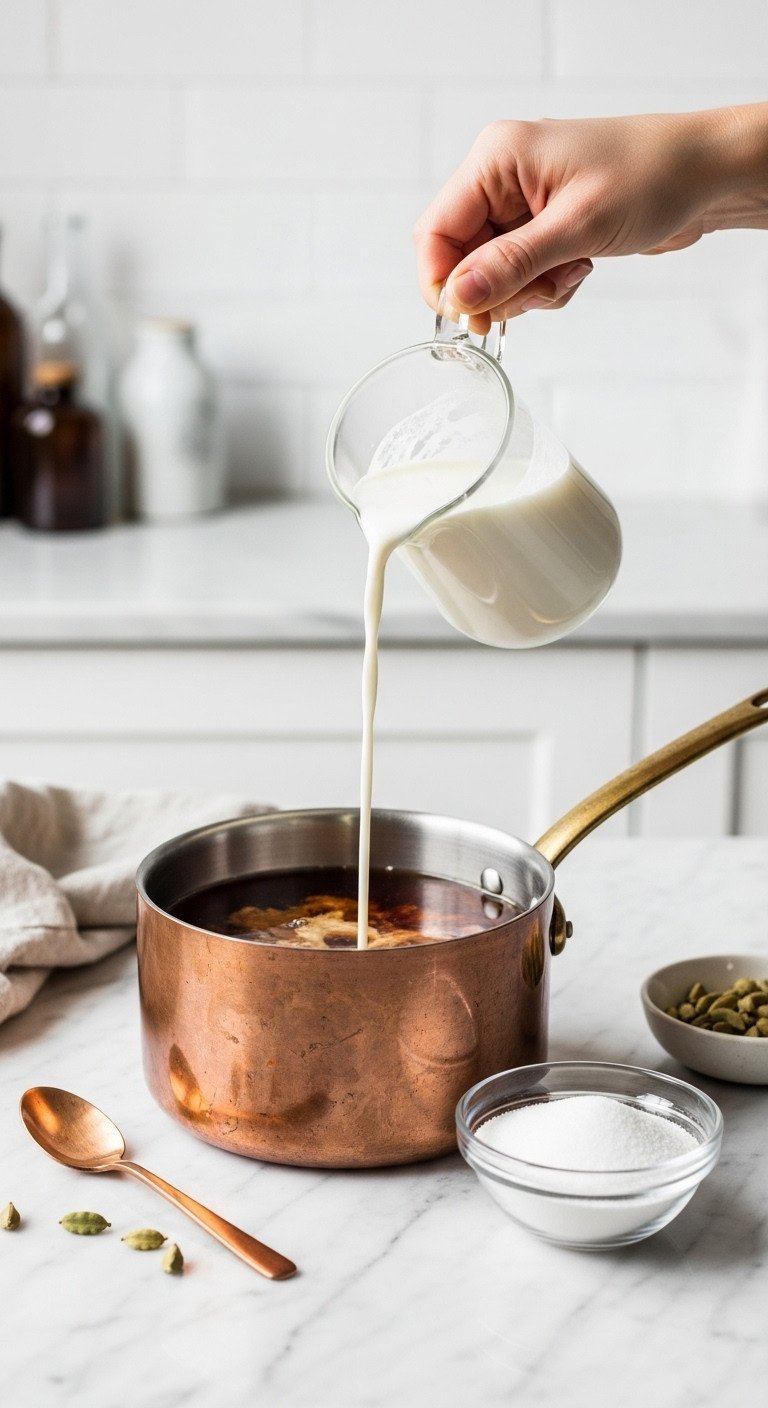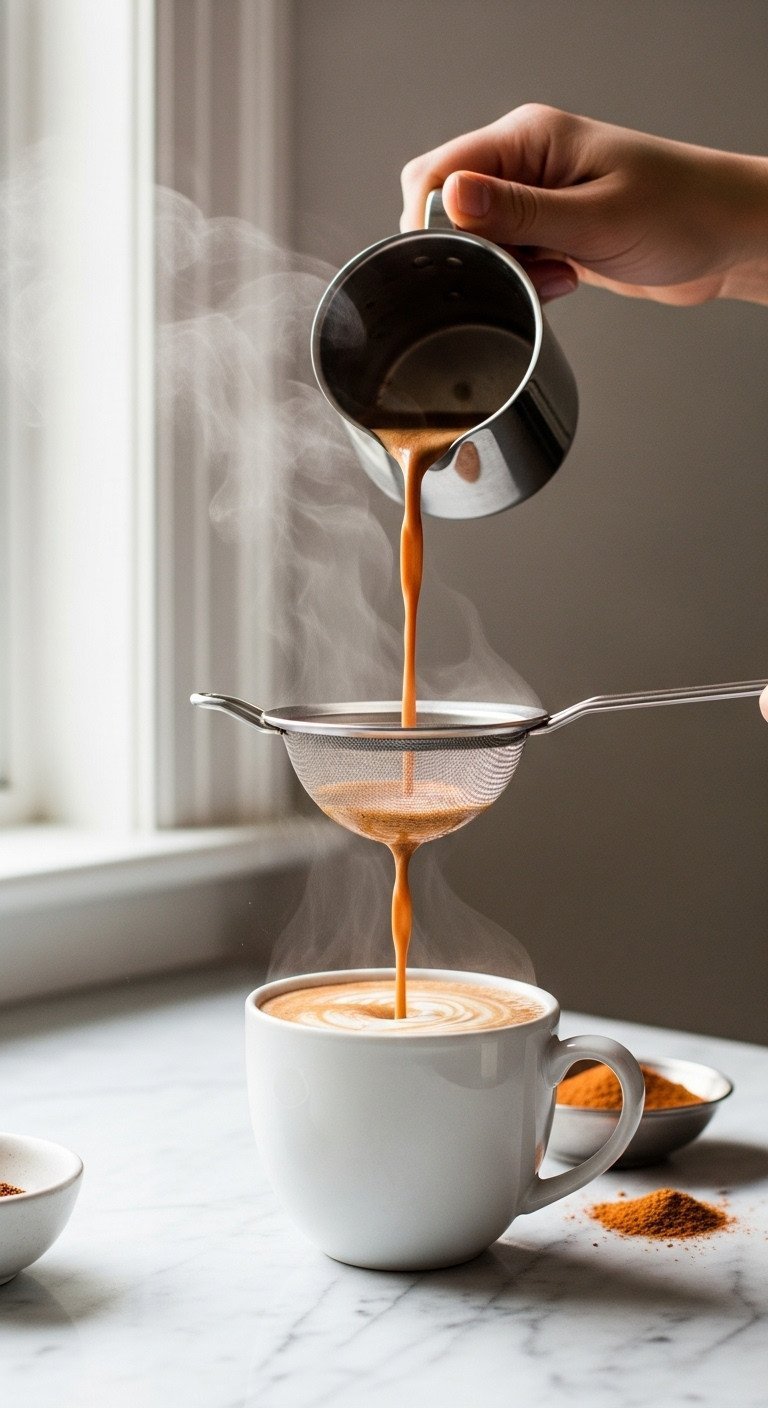As an Amazon Associate CoffeeXplore.com earns from qualifying purchases.
Master Masala Chai Perfect Ratios and Traditional Method
Have you ever spent time carefully brewing chai at home, only for it to taste disappointingly weak and watery? It’s a common frustration that leaves you wondering what restaurants do differently. You’re not just missing an ingredient; you’re missing the method.
Masala Chai is a traditional Indian spiced milk tea. It’s made by boiling black tea leaves and aromatic whole spices directly in a mixture of water and milk. This creates a rich, potent ‘decoction’ that steeping alone can’t replicate. The secret to that creamy, robust flavor you love lies in mastering the perfect ratios and a specific boiling technique.
This guide reveals the traditional method, refined through rigorous testing of Indian culinary principles. We’ll walk you through the precise water-to-milk ratio, the essential homemade spice blend, and the step-by-step boiling process. You will learn to create an authentic, full-bodied masala chai that’s never watery again.
Tired of Watery Chai? The Secrets to Mastering Authentic, Restaurant-Style Spiced Tea
The most common reason for weak homemade chai is a flawed method, not a lack of ingredients. Many recipes treat chai like regular tea, simply steeping tea bags and spices in hot milk. This approach fails to extract the deep, complex flavors from the whole spices and robust tea leaves. The result is a thin, underwhelming beverage that tastes more like spiced milk than authentic masala chai.
The solution lies in embracing a traditional Indian preparation known as decoction. Masala Chai is a traditional Indian spiced milk tea, made by boiling black tea leaves and whole aromatic spices (Chai Masala) directly in milk and water, creating a rich ‘decoction’ rather than a simple steep. This controlled simmering process is what unlocks the potent volatile oils in the spices and the strong tannins in the tea, concentrating them into a balanced, creamy, and intensely flavorful drink. By mastering the perfect water-to-milk ratio and the decoction method, you solve the problem of watery chai permanently.
The Foundation: How to Create Your Authentic Chai Masala Blend
The heart of any authentic masala chai is the chai masala, the aromatic blend of whole spices that gives the beverage its signature warming flavor. While pre-ground powders are convenient, they lack the vibrant potency of freshly crushed spices. The volatile oils that carry the most intense flavor and aroma begin to dissipate the moment a spice is ground.
For this reason, the traditional method involves using a khalbatta (mortar and pestle) to crush whole spices immediately before brewing. This ensures you capture the peak fragrance of green cardamom, the pungent heat of fresh ginger, and the sweet warmth of cinnamon. This section provides the master ratio for a perfect homemade chai masala, ensuring your brew is fragrant, balanced, and deeply satisfying.
The Core 5: Essential Whole Spices for Chai Masala

Pin this genius spice blend recipe to your ‘Authentic Indian Food’ board!
Each of these spices plays a critical role. Cardamom provides a sweet, floral fragrance, ginger adds a pungent kick, cinnamon lends a sweet warmth, and cloves offer a deep, warming flavor.
Materials Needed:
- Green Cardamom Pods (1 tablespoon, lightly bruised)
- Cinnamon Stick (1 inch, broken into 2-3 pieces)
- Whole Cloves (4-5 pieces)
- Black Peppercorns (5-7 pieces)
- Fresh Ginger Root (1 inch piece, peeled and coarsely grated)
- Optional: 1 Star Anise (for licorice note)
Step-by-Step Directions:
- Crush the Spices: Place the cardamom pods, cinnamon, cloves, and peppercorns into a heavy mortar and pestle. Crush thoroughly until the cardamom pods break open and the spices release their aroma (this is critical).
- Grate Ginger: Peel and coarsely grate or mash the fresh ginger root separately. Never slice, as slicing reduces surface area for flavor extraction.
- Combine Immediately: The goal is to use the spices immediately after crushing to capture the volatile oils. Do not crush and store the mixture.
Pro-Tip: For the most potent flavor, gently toast the dry spices (cinnamon, cloves, peppercorns, and cardamom) in a dry pan for 30 seconds before crushing. This further unlocks the essential oils.
Traditional Masala Chai Recipe: The 7 Essential Steps to Creaminess
This 7-step boiling method is the key to unlocking deep flavor extraction and achieving a perfect, creamy texture. Unlike simple steeping, this decoction process is a rigorous technique that requires precise control over heat, timing, and ratios. Following these steps guarantees a robust, balanced, and authentic cup of masala chai every time. The goal is to build flavor in layers, starting with the spices and ending with a final, vigorous boil that emulsifies the milk fats for a rich mouthfeel.
1. Determine Your Perfect Water-to-Milk Ratio

Pin the ratio breakdown! Save this guide to your ‘Best Recipes’ board.
The liquid proportions are foundational to the final texture and flavor concentration. Using full-fat milk is essential for achieving the desired creaminess.
Materials Needed:
- Water (1.5 cups per serving, filtered preferred)
- Full-Fat Milk (0.75 cups per serving, dairy or high-fat oat milk for creaminess)
- Heavy-bottomed Saucepan (must be non-reactive stainless steel)
Step-by-Step Directions:
- Select Ratio: Choose the 2:1 (Water:Milk) ratio for traditional, balanced chai, or 1:1 for ultra-rich, creamy restaurant-style chai.
- Scale Liquids: Use the 2:1 ratio (1.5 cups water, 0.75 cups milk) as the base measurement for one large mug.
- Measure Separately: Always measure liquids precisely. The initial goal is to boil the water down to concentrate the flavor, which requires the precise starting volume.
Pro-Tip: The key to creamy chai is reduction. By starting with more water and boiling it down for 5-7 minutes, you concentrate the spices and reduce the overall liquid volume, leaving a richer, more robust drink.
2. Create the Spiced Decoction Base

Watch the color change! Save this technique to your ‘Cooking Hacks’ board.
This is the most critical step for flavor extraction. Boiling the spices in water first allows their volatile oils to fully infuse the liquid base, creating a potent and aromatic foundation.
Materials Needed:
- Pre-measured Water (from Step 1)
- Freshly Crushed Spice Blend (from previous H3)
- Heavy-bottomed Saucepan
Step-by-Step Directions:
- Combine Spices and Water: Pour the measured water into the saucepan. Add the freshly crushed spice blend, including the ginger.
- Bring to Boil: Turn heat to high and bring the water mixture to a rapid, rolling boil.
- Simmer and Reduce: Once boiling, reduce the heat to medium-low. Simmer the decoction uncovered for 5 to 7 minutes. The water volume should visibly reduce by about 1/4 to 1/3, and the liquid will begin turning a faint yellow-amber color from the spices.
Pro-Tip: Simmering the spices first is crucial. This process, called decoction, ensures the non-water-soluble oils in the spices fully transfer into the liquid base before the milk or tea is added. Do not rush this step.
3. Select and Add the Strong Black Tea Leaves

Tea selection is crucial! Save this tip to your ‘Tea Time’ collection.
The type of black tea you use has a significant impact. Masala chai requires a strong, robust tea that can withstand boiling without releasing excessive bitter tannins.
Materials Needed:
- CTC Tea Granules (1 level teaspoon per 1.5 cups of initial water)
Step-by-Step Directions:
- Use CTC: Ensure you are using a strong, robust tea like Assam CTC (Crush, Tear, Curl) granules, which are designed to withstand boiling without becoming overly bitter. Avoid delicate loose-leaf teas like Darjeeling or Oolong.
- Add Tea: Once the spice decoction has reduced (Step 2), add the measured tea leaves.
- Quick Boil: Bring the mixture back to a rolling boil for just 30 seconds to activate the tea. Do not boil for long yet, as the milk is needed to temper the tannins.
Pro-Tip: If you must use tea bags, open them and use the contents, or steep the bags only for the last 1 minute of the process after the milk is added.
4. Introduce the Milk and Sweetener for Balance

Achieve creamy color! Save this to your ‘Kitchen Goals’ board!
Adding milk and sweetener at this stage is key to creating a balanced and creamy final product. The milk fat tempers the tea’s tannins, while the sugar dissolves fully into the hot liquid.
Materials Needed:
- Pre-measured Full-Fat Milk (or high-fat oat milk)
- Granulated Sugar (1-2 teaspoons per serving, to taste)
Step-by-Step Directions:
- Add Milk: Pour the measured milk into the saucepan with the tea and spice decoction. Stir well to combine.
- Add Sweetener: Add the sugar or sweetener of choice now. Adding it before the final boil helps it dissolve fully and prevents accidental scorching on the bottom of the pot.
- Increase Heat: Bring the liquid back to medium-high heat, stirring gently and continuously to prevent the milk from scorching on the bottom.
Pro-Tip: If using non-dairy milk, high-fat oat milk yields the creamiest result and is less likely to separate than almond or cashew milk. Use a medium heat setting to avoid scorching.
5. Execute the Final Simmer and Boil Down

The boiling point is key! Save this ‘Boiling Tip’ for reference.
This final boil is where all the components meld together. It fully extracts the tea’s flavor, emulsifies the milk fats, and concentrates the liquid to achieve the final rich color and creamy taste.
Materials Needed:
- Saucepan with Tea/Milk Mixture
- Stirring Spoon
Step-by-Step Directions:
- Bring to Rolling Boil: Bring the entire mixture back up to a hard, rolling boil on medium-high heat. Watch carefully—milk can boil over very quickly!
- Reduce and Simmer: Immediately reduce the heat to a low simmer. Simmer for an additional 3 to 5 minutes. The total liquid volume should reduce further, resulting in a deeper, richer color (a dark reddish-brown).
- Check Flavor: After the simmer time, taste the chai. It should be intensely flavorful, pungent with ginger and cardamom, and sufficiently sweet. If it tastes weak, simmer for another 1-2 minutes.
Lesson Learned: Never walk away from the stove when the chai is boiling. The sudden surge of foam caused by boiling milk can overflow in seconds, leading to a mess and burnt milk residue.
6. Master the Art of Straining and Aeration

The secret to frothy chai! Pin this serving technique now.
The final step separates the solid spices and tea leaves while enhancing the beverage’s texture through a traditional aeration technique.
Materials Needed:
- Fine-Mesh Sieve/Strainer
- Serving Mugs (2)
Step-by-Step Directions:
- Strain: Remove the saucepan from the heat. Place a fine-mesh strainer over your serving mug and pour the chai mixture through, ensuring no tea leaves or spice remnants enter the cup.
- The ‘Pulling’ Technique (Optional but Recommended): To achieve that signature creamy froth seen in Indian street chai, pour the strained chai between two serving mugs (or one mug and a large empty pot) from a height of about 1 foot. Repeat 3-4 times. This process is called ‘pulling’ or aeration.
- Serve Immediately: Serve piping hot.
Pro-Tip: The ‘pulling’ technique not only creates a lovely froth but also helps emulsify the milk fat and cool the beverage slightly, making it ready to drink faster.
7. Troubleshoot Common Issues: Weakness, Wateriness, and Bitterness

Fix your chai flavor! Save this troubleshooting guide to your ‘Must Try’ board.
Even with a perfect recipe, issues can arise. Understanding the cause of common problems like weakness or bitterness is key to consistently making great chai.
Common Chai Mistakes and Solutions:
- Problem: Weak, under-flavored chai.
- Solution: Increase the initial simmering time of the spices and water (Step 2) to 7-10 minutes, and ensure you are using fresh, recently crushed whole spices.
- Problem: Watery or thin consistency.
- Solution: You added too much water or didn’t reduce the liquid enough during the decoction phase. Use a 1:1 milk to water ratio next time, or simmer the final mixture longer to evaporate excess liquid.
- Problem: Bitter, overly tannic taste.
- Solution: You boiled the black tea leaves for too long after the milk was added (Step 5). Use a strong CTC tea, and reduce the final boil time to a maximum of 3 minutes.
- Problem: Raw, burning ginger flavor.
- Solution: The ginger was added too late. Ginger must be added in the initial water boil (Step 2) to ‘cook out’ its raw pungency and allow its flavor to mellow and integrate.
Best Practices:
- Use Heavy Pans: Always use a heavy-bottomed saucepan to distribute heat evenly and prevent milk scorching.
- Stir Constantly: Stir once the milk is added, especially when bringing it back to a boil, to prevent a skin from forming and the milk from burning at the bottom.
Expert Insight: Culinary experts agree that the single greatest cause of weak chai is a lack of patience during the decoction phase. Proper extraction takes time.
Beyond Traditional: Advanced Customizations and Regional Variations
Once you’ve mastered the foundational recipe, you can explore the rich world of chai variations. From modern dietary adaptations like vegan chai to the historical context of its ingredients, understanding these nuances elevates your appreciation and skill. The principles of decoction and ratio remain the same, but the components can be adjusted to suit different tastes and needs.
The Ayurvedic Wisdom of Masala Spices
Masala Chai spices were historically used for their warming and digestive properties. According to Ayurvedic tradition, ginger and black pepper help stoke Agni (digestive fire), while cardamom is used to balance and detoxify, and cinnamon supports circulation. This makes chai an ideal daily digestive tonic, particularly in cooler months.
Best Milk Alternatives for Creamy Vegan Chai
While dairy is traditional, the best vegan alternative for creamy chai is full-fat oat milk (barista blends). It has a high-fat content and a neutral flavor profile that stands up well to boiling. Cashew milk is a second option, but avoid almond milk as its low fat content results in a watery, pale chai that lacks the robust texture required.
North vs. South Indian Flavor Profiles
Masala Chai varies significantly by region. North Indian chai (Delhi/Mumbai street style) often features a higher proportion of fresh ginger and black peppercorns for intense heat, often with more sugar. South Indian chai tends to be more subtle, often using a blend of cardamom, nutmeg, and sometimes a tiny pinch of salt for complexity, emphasizing the tea’s natural flavor.
Key Takeaways: Your Quick Guide to Perfect Chai
To ensure a perfect cup of masala chai every time, focus on these three non-negotiable principles. They are the foundation of authentic, robust flavor.
- Master the Decoction: Always boil the crushed spices and water for a minimum of 5-7 minutes before adding the milk and tea to maximize flavor extraction.
- Precision in Ratios: Use a minimum of a 2:1 water-to-milk ratio (or 1:1 for extra creamy) and ensure you use a strong black tea base, like CTC, that can withstand the boiling process.
- Crush Fresh: Crush whole spices (especially cardamom and ginger) immediately before brewing; pre-ground spice powder will result in weak, flat flavor.
FAQs About masala chai recipe
Does Masala Chai contain caffeine?
Yes, Masala Chai does contain caffeine. It is made with a strong black tea base, which naturally contains caffeine, typically averaging between 30mg to 50mg per 8oz serving, depending on the strength of the tea leaves used and the duration of the brewing process.
How long can I store leftover Masala Chai?
Masala Chai is best consumed immediately while hot. If you have leftovers, they can be stored in an airtight container in the refrigerator for up to 2 days, but the flavors and creamy texture will degrade. Reheat gently on the stovetop; avoid boiling a second time.
Can I use pre-ground spices for Chai Masala?
While convenient, using pre-ground spices is not recommended for authentic Masala Chai. Whole spices, freshly crushed just before brewing, contain significantly more volatile oils, which are crucial for the intense, warming aroma and flavor that defines the traditional decoction method.
Final Thoughts
Mastering the Masala Chai preparation is about embracing the process—the crushing of the spices, the steam of the decoction, and the patience of the simmer. By adhering to the precise ratios and the traditional boiling method, you can consistently create a creamy, deeply comforting, and authentically robust cup of spiced tea right in your home. This process is more than a recipe; it’s a moment of culinary reverence.
What is the one essential spice you absolutely cannot skip in your homemade Masala Chai? Let us know in the comments below
Last update on 2025-12-05 / Affiliate links / Images from Amazon Product Advertising API

